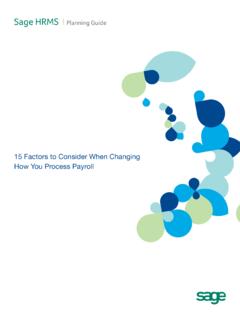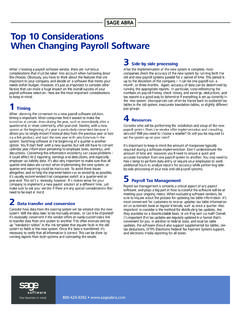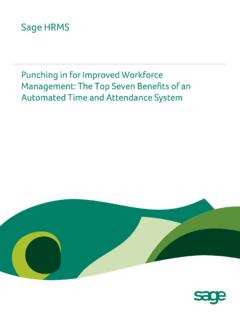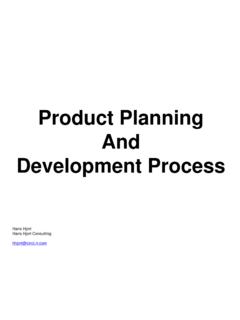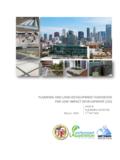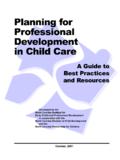Transcription of Career development planning and the changing …
1 Why the transition between different generations of workers makes it more important than everCareer development planning and the changing workforce 1 Table of contentsExecutive summary 3 The skill gap crisis and employee engagement 3 The importance of managing and developing 4 The challenge of Career development 5 What makes a successful Career development 6 Implementing your Career development plan 7 The bottom line 8 About Sage 8 How to thrive using workforce Career development planning2 Executive summaryAs the economy continues to improve after the long recession, today s companies are facing a number of workforce issues that seriously affect their performance and profitability; foremost among these is the problem of maintaining an experienced workforce in the midst of a generational shift of seismic proportions. The business world is at a significant crossroads today as massive numbers of Baby Boomers have started to retire. With the Boomer drain set to continue unabated over the next decade, one of the greatest challenges facing human resources managers is replacing the decades worth of invaluable knowledge and skills possessed by experienced Boomers.
2 How can you ensure your company is ready to overcome the dreaded skill gap so it doesn t falter and experience a significant drop off in productivity?This white paper will examine the changing workforce, the skill gap crisis, the importance of managing and developing your workforce, and the most practical and effective ways to go about skill gap crisis and employee engagementOne element that is compounding the Boomer skill gap crisis is the extraordinarily high number of employees who feel unengaged when it comes to their job. Industry research has proven that there is a strong link between employee engagement and a company s financial performance. Engaged employees are more productive and loyal and provide better customer service, and research shows that they are far less likely to bolt for greener pastures. Yet a staggering 70 percent of workers are not fully engaged according to a recent Gallup workforce talent war is always ongoing, but as the Boomers retire, it s going to take on an even greater sense of urgency for companies, and those organizations that can retain their own talent by developing skilled, engaged replacements from within are going to have the inside track when it comes to long-term performance and overcome these challenges, top-performing companies are making investments in employee development programs and providing individuals the opportunity to perform at their best potential.
3 The goal of Career development is to match employee goals with business needs and foster engagement. If managed well, development programs can both improve an employee s current job performance and prepare him or her for future growth opportunities. It is critical for HR to help design Career paths and to offer programs that help employees reach their goals, keep them engaged, and ensure the organization is ready to meet its employees are more productive and loyal and provide better customer service, and research shows that they are far less likely to bolt for greener pastures. 1 Lipman, V. (2013, September 23) Surprising, Disturbing Facts From the Mother of All Employee Engagement Surveys. Retrieved from to thrive using workforce Career development planning3An article in Harvard Business Review noted, Those organizations that invest more in talent management significantly outperform their competition across every measure of business including earnings per share, gross profit margin, and market capitalization per employee.
4 2 That s a healthy return on employee investment (ROEI) by itself. ROEI is the return in additional revenue earned or expenses reduced that an organization earns on its investment in workforce-related expenses. When looking at ROEI, your organization should also consider how a clear succession plan to replace retiring Boomers could drastically reduce employee turnover costs. Some sources estimate that it costs anywhere from 16 21% of an employee s salary to replace him or her and that for executives it can be an astonishing 213% of their s clear that talent management and Career development are more important than ever before. Many organizations are using talent management solutions to help improve employee performance management. An effective talent management solution provides tools that support dialogue and review of employee performance and offer clear development paths and easier access to training activities. It also enables employers to then create talent pools to groom top performers for additional responsibilities or importance of managing and developing your talentA major concern of businesses today is getting and keeping the right talent.
5 For example, the Department of Labor reports that manufacturing employs more than 12 million workers; however, according to a study by Deloitte LLP approximately 600,000 skilled manufacturing jobs remain If we can t fill the skills gap, it s going to be very difficult to be competitive in the global market, said Ted Toth, vice president and managing director of manufacturing technologies at Rosenberger-Toth, which manufactures parts for satellites and cellphone begs the question: With talent difficult to find in the first place, how can you develop it and then ensure that you keep it? Employee turnover is a reality in every business. Plus, employees in the youngest generation the Millennials are highly mobile today. In order to remain competitive, your company wants and needs to retain its top performers. Two of the top reasons that experts list for employee turnover link directly to employee Career development : Lack of Career growth and advancement opportunities Lack of training When looking at ROEI, your organization should also consider how a clear succession plan to replace retiring Boomers could drastically reduce employee turnover costs.
6 Employee turnover is a reality in every business. 2 Harvard Business Review, 20073 Boushey, H., Glynn, S. (2012, November 16) There Are Significant Business Costs to Replacing Employees. Retrieved from Peralta, K. (2014, May 7) Manufacturers Say Skills Gap Could Compromise Competitiveness. Retrieved from to thrive using workforce Career development planning45 Rice, A. (2012, May 15) Integrated Talent Management: What Is It and Why Should You Want It? Retrieved from integrated-talent-management-what-is-it- and-why-should-you-want-it/ 6 How to Manage Different Generations. Retrieved from generations/7 Towers Watson Global Workforce StudyHow to thrive using workforce Career development planningA robust talent management solution can serve as a remedy for employee turnover. Talent management refers to the process of developing and integrating new workers, developing and retaining current workers, and attracting highly skilled workers to your company.
7 Examples of talent management include helping your employees to learn skills needed for new projects and challenges or a higher position in the company. Managers with poor leadership skills often drive away talented top performers, so providing management training is key to further improving retention. Businesses of all sizes can tie performance and learning together in order to build a more skilled and experienced workforce, keep critical roles filled, and keep engagement levels studies reveal that integrated talent management solutions result in: 26 percent higher revenue per employee. 22 percent higher employee performance. 19 percent higher workforce challenge of Career development As technology continues to reshape how we live and work, how we view the world, and how we interact, think how much things have changed in the relatively short period since 2000. Now think how much things have changed socially, culturally, and technologically over the last six decades and how these changes have had an impact on the different generations over those 60 years.
8 We now have four different generations in today s workplace the tail end of the Silent Generation, the Baby Boomers, Generation X, and the Millennials all with very different motivations, training preferences, management styles, work ethics, and values. A fifth generation, dubbed Gen2020 or Gen Z, is on the way. As the Wall Street Journal notes, Managers are increasingly grappling with generational differences in their workforce. Problems can arise from differing mindsets and communication styles of workers born in different eras. 6 These generational differences can potentially cause misunderstandings and affect turnover and create difficulty in attracting employees and gaining employee generations do have at least one thing in common when it comes to engagement: a desire for Career enhancement. As discussed before, employees often leave their jobs in part due to a lack of Career growth and training. Additionally, engagement research has taught that: Employee engagement rises when people experience a combination of effective and caring leadership, appropriate development opportunities, and a feeling of empowerment that comes with the ability to control one s work situation.
9 7 Did you know?It is worse to give employees no feedback at all than to provide negative feedback. The feeling of being ignored leads to employee disengagement. Source: GenerationBaby BoomersGeneration XMillennialsBefore 19461946-19641965-19801980-200058 Kessler, G. (2014, July 24) Do 10,000 Baby Boomers Retire Every Day? Retrieved from wp/2014/07/24/do-10000-baby-boomers-reti re-every-day/9 Julie Halpert, Could Millennials Spawn a Productivity Crisis? The Fiscal Times, May 23, 201210 Sheehan, D. and Landauer, B. (2014, July 12) Companies Brace for Silver Tsunami as Baby Boomers Retire. Retrieved from com/2014-07-12/news/mc-lehigh-valley-agi ng-20140712_1_baby-boomers-retirement-ag e-state-employees11 Jeanne C Meister and Karie Willyerd, Are You Ready to Manage 5 Generations of Workers, Harvard Business Review HBR Blog Network, October 16, 200912 Thor Olavsrud, Tips on How IT Leaders Can Attract (And Retain) Millennials, , July 20, to thrive using workforce Career development planningBaby Boomers have been in the driver s seat in the workforce for some time now.
10 As the metaphorical changing of the guard gets under way, the Department of Labor estimates that approximately 4 million Boomers are leaving the workforce annually to be replaced by Millennials with less than ten years of Boomers are the most skilled segment of the workforce, so as they exit, that will put downward pressure on labor productivity, says Neil Dutta, an economist with Bank of America Merrill Lynch. 9 In fact, as more Boomers retire, the may have 4 million more jobs than workers to fill them by 2018, according to a 2012 report from the Society for Human Resource companies that are able to prepare for this Boomer drain and transfer the knowledge of their older workers and prepare younger workers for this transition will have a competitive advantage in the does all this mean for employers? Basically, you need to revisit your traditional methods and tailor them to attract multiple generations of talent. Instead of relying on Career fairs, consider building a social networking strategy for recruiting.
